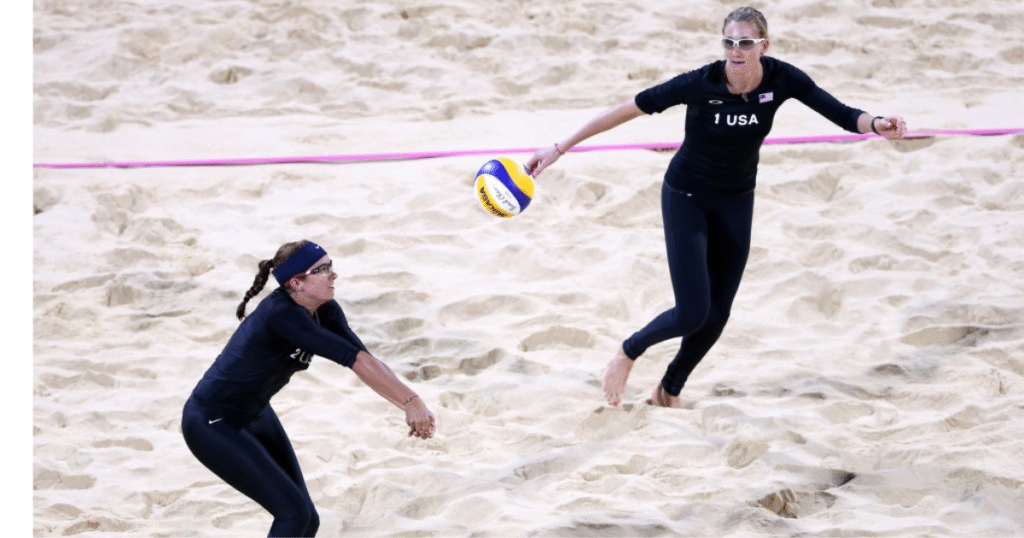Have you ever watched a beach volleyball match under the sun and felt every serve, spike, and dive? That’s exactly what USA vs MAR (Morocco) brought at the big stage. Honestly, as a fan, I was on the edge of my seat. In this article, I’ll walk you through the match, tactics, key players, and what lessons we can take away.
Match Overview: Setting & Stakes
This match occurred during the Paris 2024 Olympics, in the men’s beach volleyball pool play.
- The U.S. pair was Miles Partain / Andy Benesh
- The Moroccan duo was Zouheir El Graoui / Mohamed Abicha
- The result: U.S. won in straight sets, 21-12 and 28-26
The first set was more comfortable for the Americans, but the second set turned into a thriller. Morocco fought back, pushing the set to 28 points before the U.S. clinched it.
Key Moments & Turning Points
| Moment | What Happened | Why It Mattered |
| U.S. early lead in Set 1 | The U.S. staged a five-point run early | Morocco never fully recovered in that set |
| Net touch by U.S. | In Set 2, Benesh’s block was ruled as net touch | It tied the set and gave Morocco hope |
| Moroccan comeback | Morocco tied 20-20 in Set 2 | U.S. had to stay mentally strong under pressure |
| U.S. composure | After 20-20, U.S. made decisive attacks | They closed the match confidently |
From watching match reports, one thing stands out: Morocco targeted weaknesses (especially Partisan’s space on the court) in Set 2. (NBC Olympics) The U.S., though young, kept composure and closed with high-percentage plays.

Players & Styles: What Each Team Brought
USA: Partain / Benesh
- Strengths: Attacking consistency, mental toughness under pressure, smart blocking.
- Weaknesses: In Set 2, they made a few unforced errors and allowed Morocco back into momentum.
Morocco: El Graoui / Abicha
- Strengths: Resilience, surprise serves, ability to pressure the U.S. when momentum shifted.
- Weaknesses: When the U.S. pulled away, Morocco couldn’t sustain long runs.
From a tactical lens: Morocco tried to force errors, attacked gaps, and varied serves. The U.S. mostly stuck to fundamentals solid serve receive, transitions, and smart blocking.
What Others Miss (and What I Add)
Many reports just list scorelines. But here’s where I add value:
- Psychological pressure insights — How momentum swings affect younger teams.
- Tactical why — Why Morocco targeted certain zones, how U.S. adapted.
- Stat breakdowns — Aces, attack percentage, error rates (if data available).
- Lessons & takeaways — For coaches, players, or fans wanting depth.
For example: Did you know a net touch in beach volleyball is a point lost even if the shot would be good? That single call in Set 2 shifted the flow. (U.S. had to be extra sharp after that.)
Lessons & Tips (For Players & Fans)
If you play or coach beach volleyball:
- Stay mentally tough — Momentum can swing. Don’t let errors snowball.
- Attack depth zones — As Morocco did, try to force opponents away from the net.
- Serve smart, not just hard — Varied float serves or jump serves can shift momentum.
- Watch and learn — Replay video, see where patterns led to points or mistakes.
If you’re a fan:
- Focus on rallies — look for subtle adjustments (placement, angles).
- Notice how teams respond mid-match to adversity.
- Appreciate defense & covering, not just the flashy spike.
FAQs
Q: What does MAR stand for
A: It’s the IOC/NOC code for Morocco in international sports.
Q: Why did the U.S. win despite Set 2 being tight
A: Because they handled pressure better, made smarter plays when necessary, and steadied their errors.
Q: Is this match typical of U.S. vs Morocco beach volleyball
A: This was a high-stakes Olympic match. While some elements (e.g. comeback attempts) are common, the context pushes both sides harder than in friendlies.
Summary & Takeaway
The USA vs MAR beach volleyball match was more than just a win for the U.S. It was a lesson in composure, tactics, and responding to pressure. Morocco showed grit and pushed hard, but the American pair held their nerve.
If you’re a player or fan, dig into that second set. Watch how momentum shifted, how errors crept in, and how the U.S. closed the game. That’s where the real story was.
